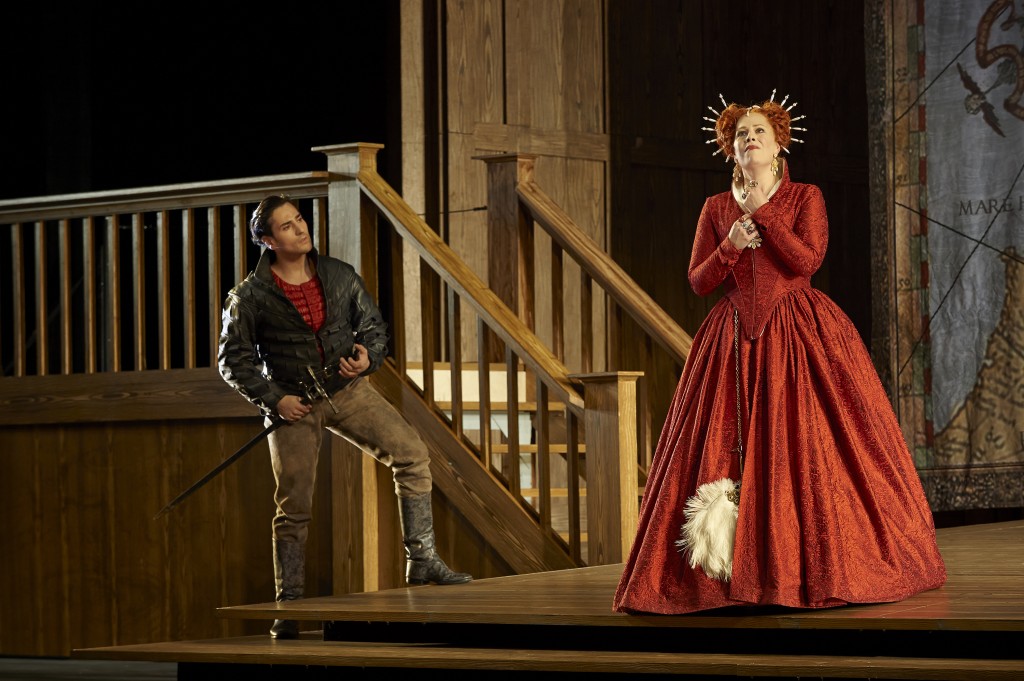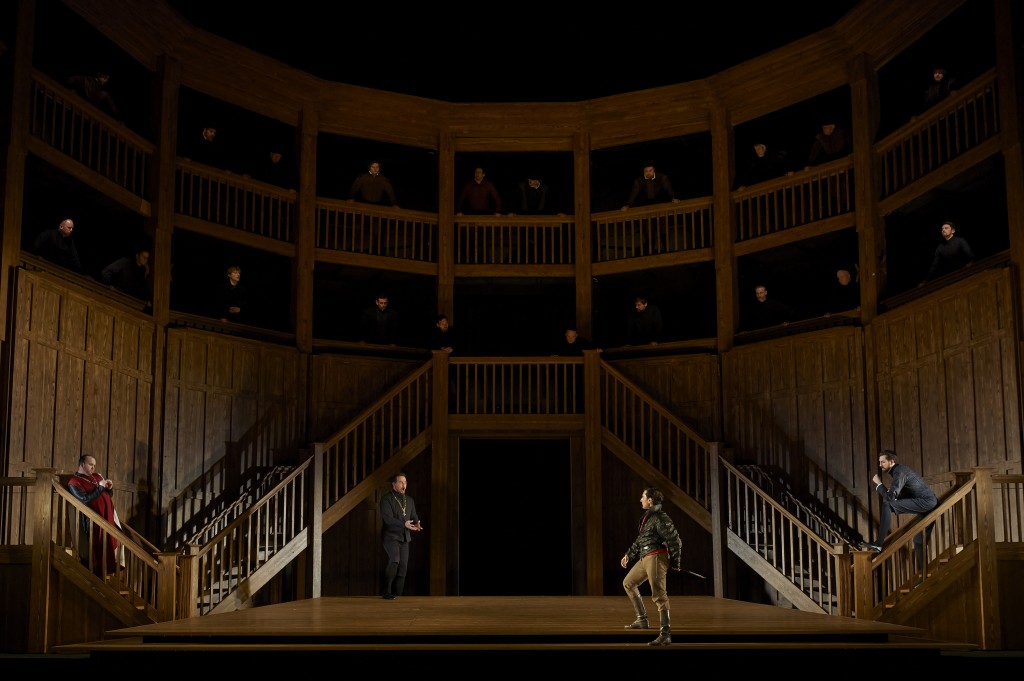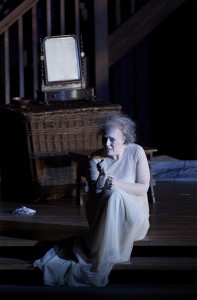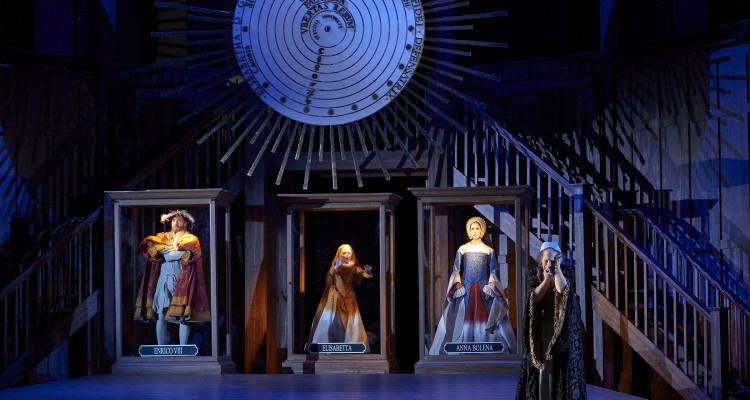The Canadian Opera Company’s production of Donizetti’s Roberto Devereux is beautiful opera with only a few kinks.

Roberto Devereux shows a jealously obsessed Queen Elizabeth I. “My wrath readies such a tomb for you that no weeping can warm it. With the dust of vile wretches will your dust be mixed!” Elisabetta to Roberto.
Don’t let the name of this opera fool you, the story revolves around the latter part of Queen Elizabeth the First’s life and specifically her obsession with the titular character. Roberto Devereux is the final installment of Italian composer Gaetano Donizetti’s Tudor trilogy, the first two also touching on Elizabeth in some way—Anna Bolena and Maria Stuarda. It is the first time this drama has been on a COC stage and overall, it is very, very good.
Roberto Devereux’s libretto by Salvadore Cammarano is clear and concise so there is never any doubt as to what is happening or why things unfold as they do—he left no room for ambiguity. It is a story we have come across many times, forbidden love, betrayal and multiple players in an ill-fated affair. Queen Elizabeth (Elisabetta) is obsessed with Devereux, he loves Sara who is both the Queen’s dear friend and the wife of the Duke of Nottingham, his close friend and trusted adviser to the Queen.
The opera begins with an open set design with three large display cases, side-by-side, appearing at the top of the overture, featuring a young Elisabetta between her parents. The statues were so perfect, that many didn’t realize they were actual actors until they became animated. And when they did start moving, they were fluid and meticulous at portraying the feelings being described.
The first act does not see the singers truly blossom, it’s not until the second and third acts that everyone on stage really finds their voice. This includes soprano Sondra Radvanovsky as Elisabetta who admittedly, sang the role beautifully and overall, delivered one of the strongest performances I have ever heard. I would say that mezzo-soprano Allyson McHardy as Sara was the most consistent from beginning to end.
Tenor Leonardo Capalbo as Devereux, Earl of Essex also begins the opera timidly, but by the time he gets to his cantabile aria in Act III: “Come un spirto angelico” he is completely smooth and engaging with each note perfectly sung as the anguished lover. Capalbo sings here in a legato style where he vocally showcases that he is half resigned to his fate while he also hopes that Sara will deliver the ring that could save his life. He redeems himself here for me and comes across as a much more mature singer and performer.
In Act I baritone Russell Braun as the Duke of Nottingham is foremost Devereux’s friend, pleading to save the Earl’s life. In this role, he remains flat vocally, but in Act II, he learns of the transgression of his friend and wife and utterly transforms into a vengeful, raging husband, full of jealousy and feelings of betrayal. We witness a palpable singing transition where Braun’s talents come alive.
Director Stephen Lawless took full control of this opera making sure that visually, everything was just right. This is reflected by a wonderfully simple set by Benoit Durgardyn. Costume designer Ingeborg Bernerth created beautiful Elizabethan costumes for the women, complete with corsets and full billowing skirts. Elisabetta’s blood red dress worn for the majority of the opera is like a bleeding heart. Mark McCullough’s lighting was perfection, appropriately coloured and focused throughout. Roberto Devereux’s direction, set and lighting forms perfect harmony.

(l-r) Owen McCausland as Lord Cecil, Russell Braun as Nottingham, Leonardo Capalbo as Roberto Devereux and Matt Boehler as Sir Gualtiero Raleigh.
Durgardyn was genius in creating his set styled after Shakespeare’s Globe Theatre. Elizabeth I reigned during the Golden Age of theatre, Shakespeare and Marlowe were writing pieces for the stage and the English Arts were abundant. The set is quite simple, made of lightly coloured wood, rounded and open, with several balconies. The multi-level balconies were utilized superbly for the chorus and helped to remind us that in that period, a monarch’s life was compared to that of an actor on stage, with people constantly lurking and critiquing their every move. People pop in and out of doors and levels and walk across the balconies slowly as if taking things in. It was utterly perfect.

Obsession and loss consume Elizabeth by the end of Roberto Devereux and Radvanovsky’s transformation is haunting.
Perhaps my biggest complaint of the night stems from the clunky set changes and in particular the first. The lights remained low as a large tapestry dropped from the rafters shrouding the stage. Every movement in the background was heard, the heavy moving of props and shuffling of feet. People all around began chattering while others looked perplexed. It completely interrupted the flow of the opera. After all the noise, one would expect a huge difference on stage, yet, there wasn’t. Add to that the fact that it took some people time to quiet down after the curtain went back up. It takes you out of the moment and is just poorly done.
The opera ends with an absolute blast. Donizetti has Elisabetta sing a final cabaletta in which we hear heartbroken deterioration manifest itself. She has reached her breaking point and her singing becomes at once soft and delicate and transforms to one of frenzy and agitation.
The final scene depicts Elisabetta in her true, aged form with wild grey hair and haunting eyes—we see what her obsession with the Earl has cost her. Earlier she sings, “To rob my heart of Roberto! It would be an equal crime to rob me of my crown,” by the end she proves this to be true. Upon learning Devereux is dead at the hands of her trusted advisor and with her friendship with Sara gone, she abdicates the throne and hands England over to her nephew King James of Scotland.
With Elisabetta having utterly given up, Roberto Devereux ends as it began. Radvanovsky walks into the sole display case, turns around and closes the door on her life and the opera. It was outstanding.
Radvanovsky stated that she hoped she would be able to transport the audience, “taking them away from daily worries and troubles, so they can sit there and say ‘wow’ that was a great journey.” Despite a few hiccups it really was a wonderful journey.
Roberto Devereux is on stage at The Four Seasons Centre until May 31. For tickets please visit: The Canadian Opera Company


Leave a Reply